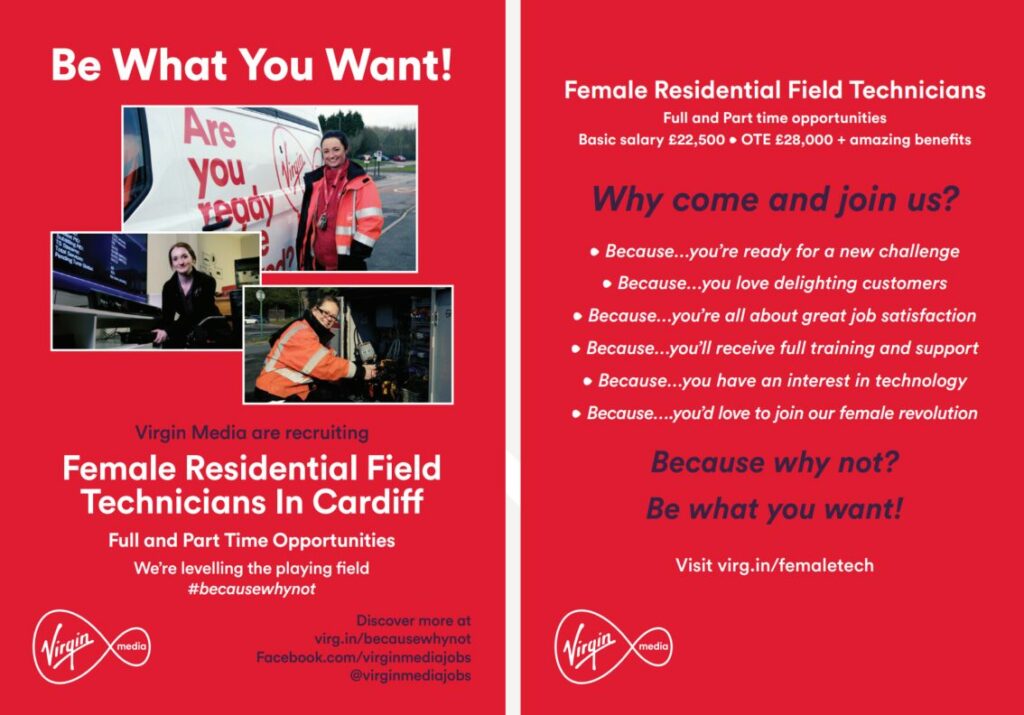
Situation
Addressing gender diversity imbalances is a priority in organizations of all types. But, for roles that enter people’s homes, that need is even more pronounced. The personal nature of that connection makes having a workforce that reflects the customers and communities served even more important.
Virgin Media goal was a 50/50 male to female employee ratio. At that point, their workforce was 73% male. so they turned to their RPO partner PeopleScout for help.
Our first move was to set up a working group to tackle the problem head on. The group immediately identified its first priority: the residential field technician (RFT) role. Out of nearly 1,300 RFTs working across the UK, only 1.9% were women.
Solution
Research
In the research stage, we analyzed application numbers from previous campaigns, and identified that applications from women amounted to less than 2% of those received.
To get clear on the role’s realities, we hosted focus groups with Virgin Media’s current female RFTs. With the insights gathered from these conversations, we built a profile of the ideal female candidate, which informed our “Women in Field” recruitment strategy.
Strategy
Our strategy was simple; celebrate female role models across Virgin Media, and transform the organization’s recruitment communications to address the motivations of our target audience. In short: surprise female candidates who hadn’t considered the role before.
We started with a pilot program launched in four key UK locations. We set the target of five women RFT hires in each of the locations with just 12 weeks from go live to offer. This was hugely ambitious, given that Virgin Media had recruited only four women RFTs across the whole of the UK in the previous year.
We transformed the campaign’s collateral, language and imagery to showcase the amazing women already doing the job. Alongside the advertising, we produced films and written profiles of current female RFTs, showing experiences, challenges and triumphs. This was supported throughout social media with hashtags such as #levellingthefield and #becausewhynot.
Ultimately, our approach was to show outstanding women doing a brilliant job so that our target audience would respond: “I’d love to do that!”

Results
The pilot was a total success. The campaign received 945 applications, with a staggering 94% of applications coming from women. We achieved the hiring target of 20 outstanding new RFTs across the four locations, and in the process, we doubled Virgin Media’s entire female RFT workforce.
Candidate engagement throughout the full recruitment process was massively improved. Drop out decreased by 37%, and more candidates than ever reached the final assessment stage.
We sent surveys to all candidates, successful or not, and overwhelmingly, responders said they found our advertisements disruptive, direct, empowering and welcoming.
Now, we’re working with Virgin Media to roll out a wider campaign, UK-wide. Our ambition is to recruit five female RFTs in every region, attracting 60% more women to these roles. Everything we achieved during the pilot will strengthen this drive, particularly as we’ve created a group of enthusiastic brand advocates—female RFTs happy to help promote referrals, reduce attrition and tell compelling stories to future applicants.
The campaign has also laid the foundations for a strong female management pipeline. As a result, Virgin Media has an emerging population of engaged women RFTs to develop into the leaders of the future.
At a Glance
- COMPANY
Virgin Media - INDUSTRY
Telecommunications - PEOPLESCOUT SOLUTIONS
Recruitment Process Outsourcing - ABOUT VIRGIN MEDIA
Virgin Media is a telecommunications company, providing telephone, television and internet services in the United Kingdom. It is owned by Virgin Media O2.








